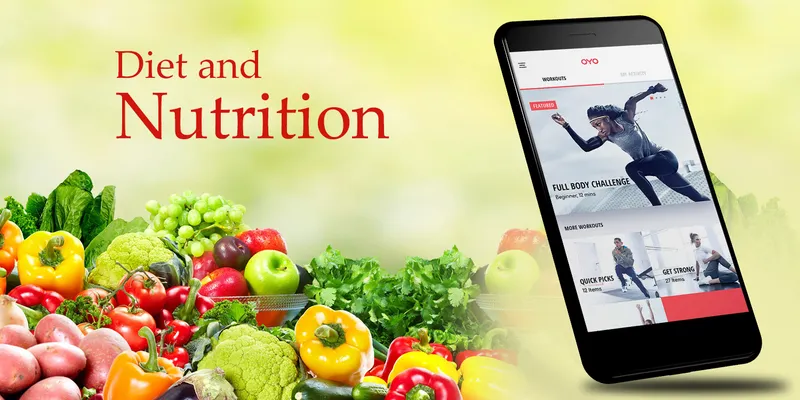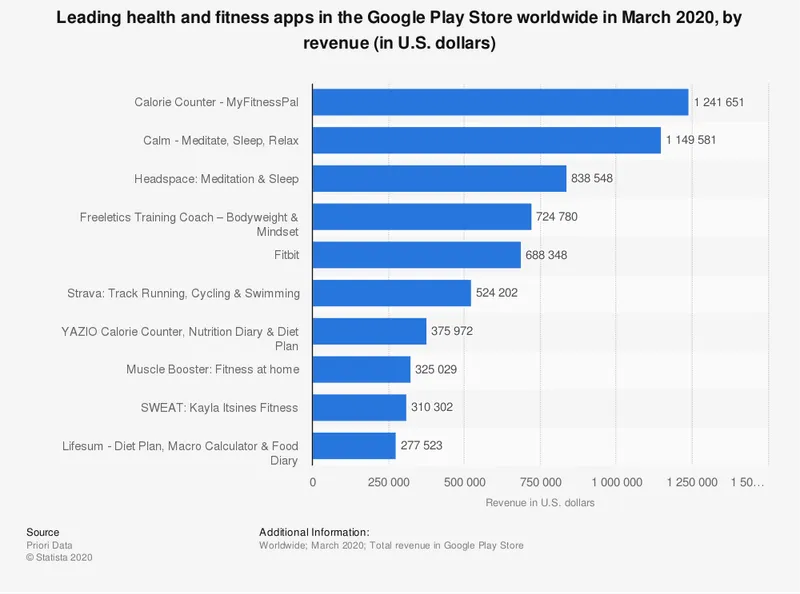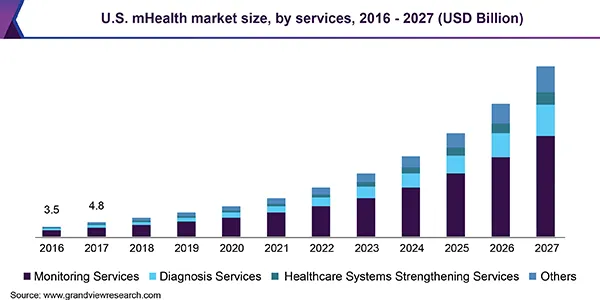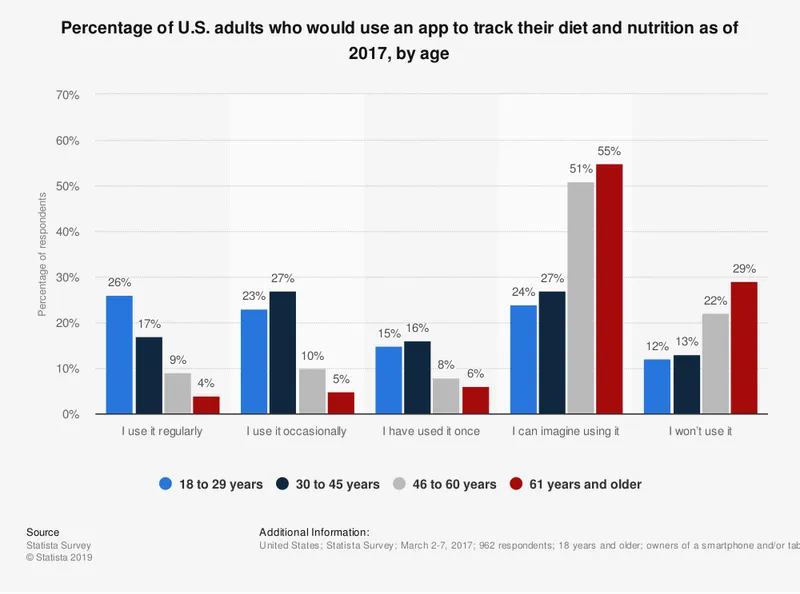

How to Create Diet and Nutrition App- A Complete Guide to Develop Mobile App

With the overwhelming popularity of healthy lifestyle movements and health-conscious eating, several businesses are looking to break into the mHealth (mobile health) market. And, investing money to develop adiet and nutrition mobile app seems a popular choice today according to Statista.
For instance, MyFitnessPal, the leading health and fitness application according to Statista, recorded a revenue of $1.24 million worldwide in March 2020.

Similarly, there is Fitbit, Lose it, and several other diet and nutrition apps with millions of active users. These apps assist users to track:
- Daily step count
- Calories burnt
- Ingredients in your daily meal and more
In this guide, I’ll cover several topics around diet and nutrition niche to assist you to develop a mobile app successfully:
Why Develop a Diet and Nutrition Mobile App?
The majority of people in the US do not have the time or money to visit a gym on a regular basis. They need a simple yet convenient tool like a mobile app to monitor their fitness level or track daily food intake. And, as businesses and entrepreneurs look for opportunities to invest in the mHealth market, developing a diet and nutrition mobile app seems a smart choice. Here’s why:
High Retention Rate- According to a recent report from Grand View Research, the global mHealth market size valued at $40.7 billion last year is expected to reach $316.8 billion in 2027 with a compound annual growth rate (CAGR) of 29.2%. The majority of the share goes to monitoring services like diet and nutrition mobile apps.

People nowadays are more health-conscious and most likely to monitor their daily intake or calorie count. The stats from Flurry Analytics suggest that around 75% of users open health and fitness apps (like MyFitnessPal) at least twice a week while 25% of fitness addicts use these apps over 10-times a week. The research studied over a 30-day retention period found that the retention rate is highest for the health and fitness app category.
As more users stay committed to their daily fitness routine, the usage of fitness mobile apps is likely to grow. Even for startups, it offers a great investment opportunity to boost monetization.
Growing usage- Over-the-years the usage of diet and nutrition apps have grown considerably. As per Statista, 26% of US adults 18-29 years of age use diet and nutrition apps regularly while 23% of them use it occasionally.

Designed to track and monitor the daily intake, the diet and nutrition apps have grown considerably in popularity and usage. From beginners to fitness addicts, apps like MyFitnessPal are suited for everyone. As reported by Flurry Analytics, the session for health and fitness mobile apps grew nearly by 9% in 2017 suggesting the growing usage of these apps.
Easy to connect with a wearable device- Food intake monitoring is becoming more digitized. By using wearables from Fitbit and other brands, people can control their diet and lifestyle with ease. Moreover, fitness apps seamlessly connect with wearables tracking the progress of the user’s fitness activity and maintain data through the app. These apps are more convenient and effective for users as it helps them achieve their fitness goals faster.
Latest Insights around Diet and Nutrition Niche- Amid the COVID-19 pandemic, life has come to a sudden halt with governments enforcing lockdown. As people are urged to work from home and stay indoors, physical activities have reduced drastically. So, in order to stay healthy and keep immunity strong, we must exercise and monitor our daily food intake through a mobile app.
To help you understand better, let’s take a look at some of the best diet app ideas that are trending today:
Calorie counter apps- Calorie calculator mobile apps measure total calories absorbed/burned by the user and even suggest diet recommendations. As the majority of people stay indoors during a lockdown, unhealthy eating habits may spur. To control weight and track daily intake, calorie count apps like Lose it or MyFitnessPal are preferred worldwide.
Social apps- As users fail to follow the correct diet and need expert advice on diet and fitness at home, social apps can be useful. Similar to healthcare mobile apps, social apps connect users with diet and fitness coaches for professional tips and suggestions. For instance, Rise - a mobile app that creates personalized diet plans and connects users with nutrition coaches for daily feedback, without costing much.
Mobile apps like these are helping users follow a strict diet plan and track daily progress at home.
Diet Planner apps- Create personalized meal plans and eat smart with diet planner apps. Unlike calorie counter apps, these apps require users to fill in their food preferences, schedules, and budget to generate the best diet plans. As lockdown extends around the globe, fitness addicts or beginners both will benefit from a diet planner app like Diet Assistant or Eat This Much.
Special diet apps- Pregnant ladies or patients with diabetes are among the most vulnerable against coronavirus. They require special care and diet especially during the pandemic when it’s risky to go outside. Using apps like Fooducate helps you create and monitor diet plans for diabetic patients. Also, Pregnancy Pounds tracks daily progress and keeps pregnant women in a healthy weight range during pregnancy. These special diet apps targeting a specific audience are highly effective.
Bet and lose weight apps- Betting money to lose a certain amount of weight in a specified time is probably the biggest motivation for users. And mobile apps like DietBet offer just that. With the motivational weight loss programs, DietBet helps you lose weight faster and without any distraction. And if the user fails to lose weight, he/she loses money as well.
Must-Have Features of Diet and Nutrition Mobile App
Sign-up and Registration Form- The primary step in diet and nutrition mobile app - registration form asks the user to fill in the questionnaire. Just like visiting a nutritionist, the app requires information like age, height, food allergies, preferred diet, and more to understand the current state of the user. It is impossible to track and monitor the diet without collecting and storage of information in the database. Moreover, the mobile app must have a sign-up option via email or social networks alongside the registration form.
Integration with Wearables- From 325 million in 2016 to 722 million in 2019, the number of connected wearable devices has more than doubled in three years worldwide. As per Statista, the estimated number will reach over 1 billion in 2022. These devices are compatible with a diet and nutrition mobile app recording vital information like calories burnt, heart rate, or pulse automatically. As fitness apps prosper with tech integration, it has become a must-have feature for these mobile apps. So, make a smart decision and implement connectivity with wearable devices in your app.
Food Dictionary and Calorie Calculator- The food dictionary and calorie calculator are the two main integrations that help keep track of what the user is consuming, serving the main goal. By leveraging the food logging (entering details about the food they’ve eaten) feature with a calorie calculator, it becomes easier to track the user's food intake and determine the calories specific food carries, accurately.
Moreover, colorful pictures can be added to the user interface to make the dashboard more appealing and interactive.
User’s Goals- Creating a diet plan is an important feature of mobile apps like Lose it or MyFitnessPal. It guides the user towards a healthy diet and caters to achieving specific goals like desired weight or shape. The user’s goal is often set up with a specified time to be followed.
Once the user’s goals are specified, the app must create a diet plan that best suits the user. Moreover, one can change the diet plan as soon as the primary goal is achieved. The effectiveness of this feature may decide your app’s growth and popularity.
Help Section and Feedback- As users get confused or have doubts regarding the scheduled diet plan, the help section can be used to go through the consultant advice. Add FAQs, tutorial videos, and maybe a chat service to answer user queries. Somewhat general, the help section is an important feature of diet and nutrition app. Similarly, feedback is another important section that helps the developer make an app smooth and clutter-free. Both these sections are extremely crucial for a fitness mobile app.
How to Add Value in Diet and Nutrition Mobile App?
While developing a diet and nutrition app requires a lot of effort, it is essential to include functionality that adds value to your app. For instance, food logging is by far the last thing most users would want to do. So, having a convenient food logging functionality may become the USP (Unique Selling Proposition) of a diet and nutrition app.
Let’s take a look at three possible solutions to speed up food logging:
Add Favorite Recipes just once - Users can input information regarding all the ingredients of a dish or add links to the recipe in the mobile app. This allows the app to automatically log ingredients in just a few taps, next time the user decides to cook the same dish.
Database on Restaurant items - Mobile app database with information from restaurants/cafes allows users to get detailed data on the ingredients of every menu item. This feature has been successfully integrated into MyFitnessPal - a popular health and fitness app.
Use of Advanced Technology - Implementing advanced technology allows developers to improve food logging in a mobile app. For instance, OCR (optical character recognition) uses a device camera to extract text from an image automatically. Also, image recognition is another popular feature that analyzes the picture and offers suggestions to the user. The users can choose from the suggestions list and get complete information about the ingredients. Lastly, barcode scanning is also used to add value.
Moreover, there are several premium features like ad-free content, food analysis, Food Timestamp, and more as offered by MyFitnessPal. You may provide these additional features in a premium subscription while offering free services to the public. This is a good way to monetize and add value to the mobile app.
Get Help with Diet and Nutrition Mobile App Development
In order to develop a successful diet and nutrition mobile app, you need a skillful team capable of handling such dedicated projects. Consult the experts at FATbit Technologies to develop your diet and nutrition mobile app. We strive to deliver custom mobile applications to clients. Our development process involves complete market study, platform selection, MVP (minimum viable product) analysis and much more to help transform the mobile experience. We offer secure and scalable solutions for both iOS and Android app development.
Conclusion
Diet and nutrition mobile apps have tremendous scope especially now with social distancing and lockdowns. As users look for better ways to monitor their intakes and stay fit, diet and nutrition app is the way forward. This guide will provide you an insider’s view on the latest trends, features, and overall development of these applications.



![Top 10 Cheap Indian Press Release Distribution Services [Updated]](https://images.yourstory.com/cs/1/b3c72b9bab5e11e88691f70342131e20/LOGO-DESIGN-PR-INDIA-WIRE-03-1595693999405.png?mode=crop&crop=faces&ar=16%3A9&format=auto&w=1920&q=75)



